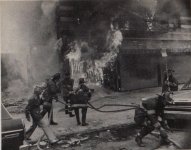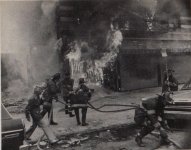The BXCO’s first order was to special call Engine 82 and H&L 31 to Box #2953, the abandoned building fire (a circumstance those companies would become quite familiar with in the coming years). This incident kept All Hands working for several hours.
The size up at Box #2941 was reported by L27 as heavy fire in the basement and first floor. This building had served several purposes since its construction in the early years of the 20th Century. Initially it was a burlesque show/movie house, which accounted for the marquee over the entrance way. It later became a furniture showcase and repair store and, if memory serves me, was manufacturing artificial flowers at the time of this fire. Years of oils, glues, and wax used for these products had permeated its wooden floors allowing the flames, once ignited, to rapidly spread.
Reinforcements were now needed at Box #2941, but nearly all the 1st and 2d Alarm companies normally assigned to this location were working elsewhere. As always, the members of the BXCO were on top of things. They transmitted instead a Dispatchers 3d Alarm for Box #2904, located a quarter mile south at 173d Street at 3d Avenue. This would bring the full 3d Alarm assignment for that box to the scene without having to go through the rigmarole of pounding out on the telegraph bells numerous special call signals to Box #2941.
First to arrive were Engine 50 and H&L 19, who operated as the 1st alarm, 2d due companies. I believe they were assigned to open up and stretch a hose line into the rear of the fire building. Next in was Engine 48, normally 1st due on the 3d alarm; instead, E48 went to work as the 3d due engine on the 1st Alarm. (Make note of that.) They were assigned to operate a cellar pipe at the sidewalk entrance to the basement, just below the marquee. As fate would have it, H&L 44 was released from its incident on Macombs Rd. just moments before. They responded as the 2d Alarm ladder company, assigned to ventilate the second floor of the fire building, above the marquee. The Dispatchers 3d Alarm also brought a Deputy Chief and his Aides to this fire.
The stage was set for tragedy.
To be continued…
We all know what happened next. The marquee, weakened by the intense flames, crashed to the street, bringing with it most of the front wall. Six firefighters perished, most of them in an instant. I will list their names again.
Lt. John F. Molloy E48
Fireman Edward J. Carroll E48
Fireman Frederick J. Hellauer E48
Fireman Arthur G. Hanson L44
Fireman William P. Hoolan L44
Fireman Charles J. Infosino Chiefs Aide
The details are in the accounts in WNYF and The New York Times, posted on this thread by our colleague Mack. All of the City newspapers (and there were many back in 1956) plastered the story across the front pages.
Following the TV news flash, Uncle Charles did call back to my mom. He had called the BXCO, identified himself, and was told that his brother was not at the collapse site. I was correct, that location was at the boundary of Engine 88s response area. They could, or should, have been there; but they were not in this instance. For this nine-year-old, some of life’s vagaries, such as timing, circumstance, fate, and even luck, began to come in focus.
How long had it taken H&L 27 to get out from quarters and roll those short blocks down 3d Avenue and be intercepted? A few minutes at most. If instead the young man that flagged them down had happened by the spot only those few minutes before he might have pulled street corner Box #2941. E88 would then have been headed there instead of to Box #2953. As the 3d due engine they likely would have been operating that cellar pipe, the one that wound up fatally in the hands of Engine 48.
Lt. John J. Molloy and my father were officers in adjacent companies within the same 18th Battalion. They had known and worked with each other for years, perhaps going back to their days fighting fires in Harlem. Both my family and the Molloy’s lived on East 199th Street, but on opposite sides of the Grand Concourse. And Danny Molloy was a nine-year-old third grader just like me. I did not know him as we attended neighboring parochial schools. Many of the kids on my block, his schoolmates, did and spoke well of him. In the days following the fire the New York Daily News published a poignant photo of his family (mother, older sisters, and Danny) that chilled me to the bone. It very well could have been my family in that photo, and I knew it. Why he and not me?
Fireman Eddie Carroll of E48 was also a neighborhood resident and family friend. He was also the son of an FDNY LODD, one of the few father/sons in Department history. The father was killed while a member of H&L 48. I suppose that the number forty-eight is not a favorite in that family.
Among the WNYF photos posted above in this thread is seen E48s entire crew operating the cellar pipe. Just moments after it was taken, Lt. Molloy relieved Firemen Hesse and Casario to take a blow. They were only a few steps into the street when the wall collapsed. Both were hit from behind with debris and hospitalized, but they survived. (Fireman Hesse’s son attended Power Memorial Academy in Manhattan with my older brother.)
E48s chauffeur (his name lost to me now) had driven to Box # 2941 in their classic Ahrens Fox pumper with an officer next to him in the cab and four firemen on the back step. After the collapse, he insisted he drive the rig back to quarters by himself. An old-timer, “it was to me to return the horse to the barn”, he supposedly said. God knows his thoughts as he returned alone. He then collected the shoes of all his fallen brothers, scattered about the apparatus floor, and placed them in their lockers.
To be continued…


